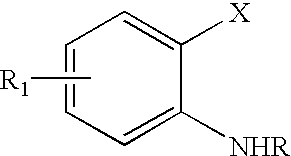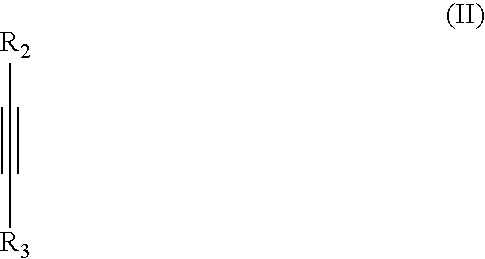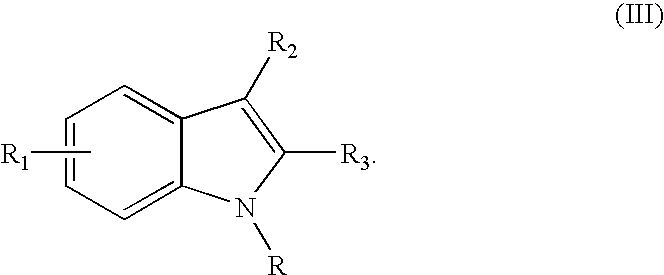Palladium catalyzed indolization of 2-bromo or chloroanilines
a technology of indolization and palladium, which is applied in the field of pharmaceuticals, can solve the problems of not finding that indolization provided better, challenging regioselective formation of indoles with substitution at positions other than c-5, and the protocol of larock is not applicable to the indolization of acetylenes with 2-bromo or chloroanilines
- Summary
- Abstract
- Description
- Claims
- Application Information
AI Technical Summary
Problems solved by technology
Method used
Image
Examples
example 1
Synthesis of 5-methyl-2-phenyl-3-propylindole (1a)
[0075]
[0076] Pd(OAc)2 (11 mg, 0.05 mmol), 1,1′-bis(di-t-butylphosphino)ferrocene (DtBPF) (47 mg, 0.1 mmol) and K2CO3 (346 mg, 2.5 mmol) were added to an oven-dried reaction vial. The vial was purged with argon. 2-Chloro-4-methylaniline (123 μL, 1 mmol), 1-phenyl-1-pentyne (192 μL, 1.2 mmol) and 1-methyl-2-pyrrolidinone (NMP) (2 mL) were added via syringe. The reaction was heated to 130° C., stirred at the same temperature and monitored by HPLC. The reaction was complete after 4 h. The ratio of the desired regioisomer (1a) to the by-product (1b) was 91:9. The mixture was filtered through a pad of diatomaceous earth. The cake was washed with EtOAc. The combined organic filtrate was washed with water and brine, dried over MgSO4, filtered and concentrated to give a brown residue. The product was purified via column chromatography.
[0077]1H NMR (300 MHz, CDCl3) δ 7.90 (s, 1H), 7.60-7.00 (m, 8H), 2.80 (t, J=7.0 Hz, 2H), 2.48 (s, 3H), 1.75...
example 2
[0078] The following examples illustrate the general applicability of the palladium catalyzed indolization.
3-Ethyl-2-isopropenyl-5-methyl-1H-indol
[0079] A 100 ml reaction flask equipped with a stirring bar and thermocouple are charged with Pd(OAc)2 (56 mg, 0.25 mmol), DtBPF (142 mg, 0.3 mmol), 2-chloro-4-methylaniline (0.71 g, 5 mmol), 2-methyl-1-hexen-3-yne (0.94 g, 10 mmol), K2CO3 (1.73 g, 12.5 mmol) and DMF (50 mL). The flask was purged with argon. The reaction was heated to 110° C. and stirred overnight. The reaction was complete after 20 h at 110° C. The mixture was filtered through a layer of diatomaceous earth and washed with EtOAc (10 mL). The filtrate was diluted with water (50 mL), extracted with EtOAc (100 mL×3). The combined organic phase was washed with water (50 mL×4) and brine, dried over MgSO4, filtered and concentrated to give a dark brown residue. The product was purified via chromatography on silica gel (hexane / EtOAc 50 / 1). The desired product was obtained as a...
example 3
Synthesis of 3-cyclopentyl-1-methyl-2-pyridin-2-yl-1H-indole-6-carboxylic acid methyl ester (13)
[0105]
[0106] A 100 mL three neck flask equipped with a thermocouple, condenser and stir bar was purged with argon. 3-Amino-4-chlorobenzoic acid methyl ester (5.0 g, 26.94 mmol), 2-cyclopentylethynyl-pyridine (5.528 g, 32.33 mmol), Pd(OAc)2 (181 mg, 0.81 mmol), DtBPF (767 mg, 1.62 mmol), K2CO3 (9.29 g, 67.35 mmol) and NMP (25 mL) were then charged. The reaction was heated to 130° C. and monitored by HPLC. The reaction was complete after 6 hours.
[0107] The reaction was cooled to room temperature. DMC (11.4 mL, 134.69 mmol) and tetrabutylammonium bromide (TBAB) (0.868 g, 2.69 mmol) were added. The mixture heated to 130° C. HPLC showed less than 3% starting material remaining after 4.5 h. The mixture was filtered through a pad of diatomaceous earth. The black cake was washed with i-PrOAc (50 mL). Solution yield of this mixture was 78%.
[0108] The crude product residue was dissolved in i-PrO...
PUM
| Property | Measurement | Unit |
|---|---|---|
| temperature | aaaaa | aaaaa |
| temperature | aaaaa | aaaaa |
| wavelength | aaaaa | aaaaa |
Abstract
Description
Claims
Application Information
 Login to View More
Login to View More - R&D
- Intellectual Property
- Life Sciences
- Materials
- Tech Scout
- Unparalleled Data Quality
- Higher Quality Content
- 60% Fewer Hallucinations
Browse by: Latest US Patents, China's latest patents, Technical Efficacy Thesaurus, Application Domain, Technology Topic, Popular Technical Reports.
© 2025 PatSnap. All rights reserved.Legal|Privacy policy|Modern Slavery Act Transparency Statement|Sitemap|About US| Contact US: help@patsnap.com



